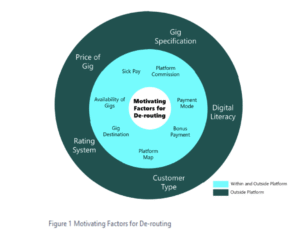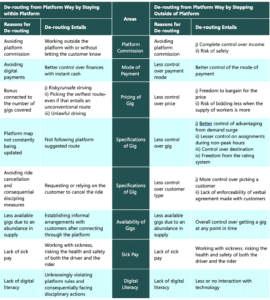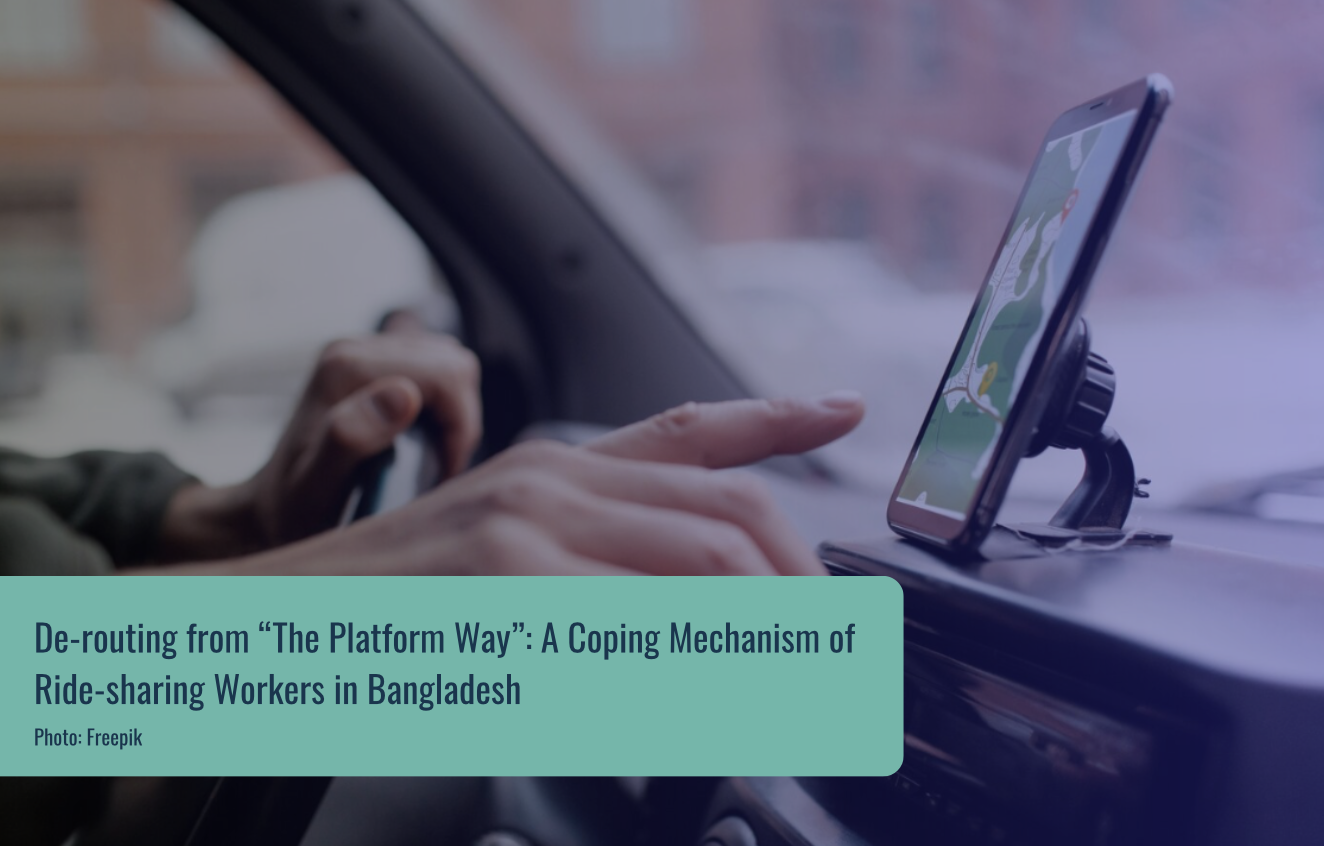Since the operationalization of Uber Bangladesh in 2016, almost six years ago, the ride-sharing industry in the country has been experiencing an interesting journey.

Currently, 15 platforms are registered under the Bangladesh Road Transport Authority (BRTA) for conducting ride-sharing business in the country. Out of these 15 registered platforms, 2 of them – Uber and Pathao – have successfully gained the majority share of the market, both in terms of drivers and riders. Uber and Pathao have been leading the ride-sharing market in Bangladesh for quite some time now. But even with such a strong competitive advantage, these platforms are struggling to offer a better workplace for their drivers..
This has resulted in the rise of a new phenomenon called ‘Khaep’ or “contract riding” where drivers directly connect with riders, bypassing the platform and their app-based infrastructure. Khaep is typically an extreme case of abandoning the platform or de-routing from the way or rules set by the platform. There is also a milder course of action wherein drivers do not fully abide by the rules of the platform, thus risking their ratings and presence on the platform, and the safety of working.
In both cases, drivers are demotivated to follow the platform way for many reasons affecting their income from, and flexibility to work with, the platforms. Table 1 (below) points out a few areas of friction that are motivating the riders to de-route from the platform way.

Table 1 De-routing from Platform Way
Platform Commission: At present, the rates that are being charged by the platforms as commission or service charges vary from 15% to 25%. Such high charges are problematic for drivers as they result in a reduction of their earnings, on top of additional costs they must bear to work for the platform. High commission rates have forced workers to either use the platform to identify riders and later on cancel the ride (with or without notifying the rider), or directly look for and get riders outside the platform.
For the former course of action, drivers are still staying within the platform but taking quite a few risks, including their rating in the platform, access to platform services for disciplinary actions, and the enforceability of the verbal agreement with riders. Despite these risks, this form of Khaep has been a common practice among many workers. As a preventive measure against future risks, many drivers also attempt to establish a connection with their riders so that the riders can reach out to them directly for future needs.
For the second form of Khaep, working outside the platform, drivers avoid the payment of commissions and enjoy total control over their income. This, however, comes with the risk of safety as drivers are randomly connecting with customers from the streets, without having any information on them. Despite such risks, there is a huge number of workers currently in the streets of Dhaka who are operating totally or partially outside of the platform for the purpose of gaining better control over their income.
Mode of Payment: With the rising use of digital financial services by Bangladeshis, the platforms took no time to integrate such services within their system. This enabled the platforms to have direct access to the payments made by the customers. For workers, this meant delayed access to their income. This system gave rise to a new problem for workers as some or most of their earnings are coming through the platforms, a few hours after they have completed the gig, and they have no control over the percentage of the earnings they will be receiving with a delay. This results in a lack of ample cash with the workers, to pay for their daily costs. For many, this also entailed an additional charge for the workers to cash out their earnings from the digital finance ecosystem. Such a challenge forced the workers to ensure gigs where payments will not be made digitally, and this resulted in them either canceling rides with digital payments or requesting the riders to pay with cash at the end of a gig. For both cases, they are de-routing from the platform preferences, risking a deactivation or suspension from the platform for cancelling multiple rides. While the preference of payment mode might not be a core reason for a worker to leave the platform, it does come to the list of pros and cons for most of the workers when they are deciding to de-route.
Pricing of Gig:
The price of a gig contains two core components: 1) the price of performing the task and 2) any bonus payment in addition to the price. The first component is usually determined by the distance traveled and the time spent for a gig, but also by demand surges or discounts enjoyed by customers, etc. This leaves the workers with no control over the price set by the platforms. Vehicle drivers are also offered bonus payments for different types of behaviors, all connected to completing more tasks on the platform. Additionally, workers that complete more gigs are paid more. All of this motivates the workers to spend the shortest time in each gig. Considering the traffic situation and the availability of many routes to reach a certain destination, the workers usually pick the swiftest routes, even if it is unconventional or different from the one suggested by the platform. For example, to avoid traffic, it is common tosee drivers opting for a longer route that has little to no traffic. Many drivers have told us they got suspended for deviating from the platform suggested route multiple times. Thus, ride-sharing workers completing their gigs face the conundrum of choosing between the swiftest route and the risk of suspension, often opting for the former motivated by better earnings. Another behavior connected to this tendency of completing more gigs is to drive in a risky or unlawful manner to get out of traffic congestion and bear the risk of getting fined. Here the prospect of earning more prevails here as well.
Those who are sharing their rides by staying outside of the platform, however, have the freedom to bargain the price for which they are traveling, and as a result, they can fix the price of their own efforts, considering their understanding of the traffic situation and the roads. This eliminates the motivation to adopt unsafe measures to complete a task, as they have full control over the price and can devise a pricing strategy that they think is appropriate. This also comes with a certain risk, when the supply of workers is greater than the demand, the workers are forced to offer lower prices to stay competitive. They could have avoided such losses by staying within the platforms, as many platforms have a pricing method to ensure a minimum payment regardless of the demand. Another initiative by some of the platforms, to give the workers more control over the prices, is the introduction of a price bidding system. This has enabled the workers to state their own prices for a gig and the option to not go for a gig that is not offering an acceptable price for their efforts and costs. Such initiatives by the platforms are motivating the workers to stay within the platform. as the motivation to adopt risky measures is eliminated to an extent.
Specification of gig: A gig comes with different characteristics such as the destination, the type of customer, the distance traveled, the route, the duration , the time of the day , the price , the mode of payment, etc. Platform workers have little control over these specifications and any type of non-compliance relating these specifications often leads to disciplinary measures, such as a lower rating. For example, the lack live updates about the different routes in the city, due to traffic congestion, some special occurrence (VIP movement, construction work, etc.), or updates in routes, can result in a mismatch between the platform-suggested route and the route that was taken during the trip. Such mismatches have been reported to be considered as der-outing from the platform way. But workers are often forced or influenced to de-route from the suggested route in order to provide a better service to the customer. Although there are mechanisms within the platforms to understand the cause of such mismatches, the algorithms are yet to have a complete understanding of such situations.
Another challenge faced by the workers while operating on a platform is when the gigs they are offered do not contain their preferred specifications and they have to cancel.. But, as many platforms do not encourage multiple cancellations from a worker, and have disciplinary measures for such cases, many workers have to look for other methods to avoid the trip. To tackle this problem, often workers request customers to cancel the ride.This, however, is not accepted by the platforms and, if reported, the platforms may suspend the worker’s account temporarily.
The workers working outside the platforms can avoid such risks and can choose freely the gigs that align with their preferences. Again, this also comes with some risks.
Availability of Gigs: With the rising earning prospect created in the ride-sharing industry, there’s been abundance in the supply of workers, that exceeds the demand from customers. This mismatch in the demand and the supply is impacting the availability of gigs. Such uncertainty among the workers has given rise to the tendency of establishing informal arrangements with customers after connecting through a gig and to work outside the platform in those established arrangements. With this arrangement, drivers can gain more certainty over their income and avoid the platform commission, while the customers get to save money and time looking for a driver on the platform.. This deviation from the way of the platforms bears the risk of unenforceability of verbal agreements for the workers, as well risks arising from customers, since the connections are built based on one or two trips.
For the workers working in Khaep mode, they are dealing with the abundance of ride-sharing workers by attempting to identify customers on their own, by stationing themselves at busy spots with high demand. As discussed earlier, this method gives them better control over the specifications and price of the gig but also comes with a few risks.
Sick Pay: In contrast to workers under formal employment, Most gig workers do not get any pay if they cannot work due to sickness or accidents. Drivers working within or outside the platform, often feel the need to work and earn even during sickness, risking their own health and safety and that of the customers This is again not something that the platforms suggest doing, but there are not enough preventive measures against it.
Digital Literacy: The availability of gigs and easy access to the platforms h ave led to a wide range of people joining the platform economy, even those that are less accustomed to digital tools.. However, new workers with lower digital literacy will often fail to comply with the many rules set by the platforms, resulting in disciplinary measures. This may create resistance and encourage them to work outside the platform.
Towards a better workplace
While the ride-sharing industry has created new work opportunities for many, it is quite evident that the platforms are yet to design their services to best serve both the workers and the riders. This has led many workers and riders to connect and operate outside of the platform, bearing many risks. Thankfully, the challenges faced by platform workers to work within the platforms are solvable. From our discussion on the few factors motivating the workers to de-route from the platform way,, the following measures can be adopted by the platforms to ensure a better workplace for their workers:
- Devising the platform commission in a way that does not harm the earnings of the workers significantly. The commissions could be set as a mixture of a flat amount and certain varying percentages, based on the specifications of the gig.
- Enabling the vehicle drivers with the flexibility to opt for gigs that offer payment in their preferred mode and/or working on ensuring the instantaneous payment transfer to the workers’ accounts with no additional charge.
- Designing a better pricing model which will ensure workers earn a living wage.
- Facilitating the workers with more information on the specifications of the gig they are being offered so that they can make an informed decision.
- Providing the workers with policies such as sick pay which will enable them to take leave of absence without significant loss of income.
- Offering a training or orientation session, digitally or in-person, for the workers to understand the ins and outs of the platform interface and familiarise themselves with the different provisions of the platforms..
- Understanding the drivers’ needs better and developing the platforms to be more user-friendly for these individuals.
Author: Ainan Tajrian
Research Manager, Fairwork Bangladesh Ratings 2023
Former Research and Business Development Associate, DataSense at iSocial





